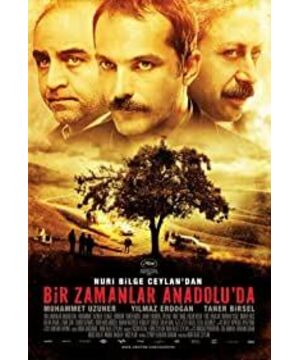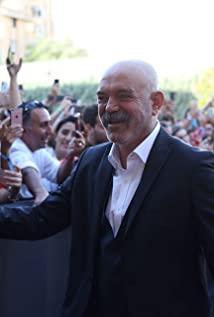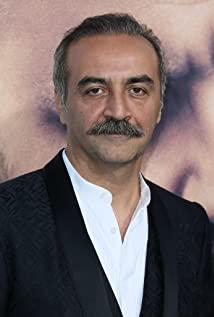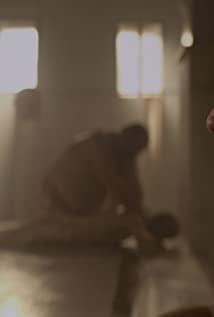modern wilderness
Looking back at the beginning of the film, Ceylon's iconic long shot - in the dark night, three cars were on high beams, the interlaced beams created a stage-like illusion, and the mottled light and shadow constructed a strange field. In the meantime, people and things are both vague and clear. The appearance of the person is blurred, the face is placed in the distance, and the dim figure is indistinguishable. But the position of the people is clear. The two suspects are being pushed and shoved, the police and soldiers are guarding them, and the civilians or superiors are watching from a distance. I couldn't help but cheer up and carefully speculate on the relationship between these characters and even the possible development direction of the plot, for fear that I would not be able to keep up with the plot in the future. Because in my imagination, the film will begin to tell a complex story about crime detection, or a past that involves generations and a grand historical background. But as the viewing continues, the film titled "Once Upon a Time in Anatolia" does not seem to have much storytelling ambition, and the two and a half-hour film is almost occupied by trivial matters in a small format...
Stories - Trivia, Inverted Exhibition
Someone on the Internet commented on "Once Upon a Time in Asia Minor": "It took too much time and said too little." But in fact, there are not many "things" in the film. The two and a half hours of the film shows no signs of experimenting with the image itself. Almost all of them are talking about "things". The characters in the film are chattering endlessly. on the screen. So what exactly is so little "thing"? I think they are referring to the "story", the main plot - a group of people left the city late at night, took the suspect along the road to find the place where the body was thrown, and returned with the body after finding it; dissecting the body according to procedures and regulations to clarify the cause of death. The story is bland and seems to be worthy of the label of the murder case, the conflict and the climax are canceled, the suspect's initial denial (withholding the exact location of the body) and the confession after a period of time (explicitly telling the location) are not enough. Provide dramatic tension - he has no real resistance, and the crime is a certainty.
Unlike the decorative trivia commonly found in literary narratives, the film inverts the structure of the story-trivia, the trivia is pushed to the front of the stage for exhibition, and the story is "told too little". This kind of treatment seems to be the handwriting of anthropologists. "Someone illegally takes another person's life for some reason", which itself can happen anywhere in the world, but different cultures and societies react to it differently. According to the aesthetic paradigm of suspenseful criminal investigation works, how the murder happened, how it was detected, the motive for it, and the plot that could serve to resolve these contradictions are the focus of the narrative, that is, the "story" that the audience and readers are willing to read; The small talk and scene description of the case are decorations for the detection of the plot (such as the creation of the scene atmosphere), and may also be key clues. That said, trivia usually exists for the sake of the main story.
But in this film, we see the other side of trivia, or another possibility for story-trivia structures. On the way to find the body, the police officers talked about their favorite varieties of cheese not to add to the atmosphere; when they were resting in the village, the village chief talked about the repair of the mausoleum and the government funding, and the driver said that his wife was also from this village. The subsequent confession of the suspect has nothing to do with it; even in the end, when the audience already knows the whole story, the camera still faithfully shows the tedious process of disposing of the victim's body. Trivia no longer serves "story", the exhibition of trivia itself has become the purpose of existence, but the case has become an excuse and perspective to spy on trivia. It is not difficult to understand the author's intention. The universality of trivia in a particular culture is "superior" to the externally constructed crime stories that are dramatized, and in a sense, it is more worthy of the grand proposition of "a certain place".
Unnatural death
Life and death as purely animal behavior may be a rare commonality across cultures. When death occurs, it is as if all carefully constructed political structures, cultural metaphors, and symbolic systems appear to be crumbling, but are in fact intact. How to interpret death, and deal with it and its attendants, is a simple yet complex question—not necessarily the right answer, but the satisfying one.
The film is about a wrongful death—a horrific homicide, murder. From the beginning, the film takes us on the way to find the place where the body was thrown, implying that the work of the previous murder, the detection of the case, and the interrogation of the suspect has been successfully completed. When a murder occurs, social norms demand that the truth be revealed (explanation provided) and the killer be punished (order declared). The evidence must be sufficient (arguments to explain) and the sentencing must be justified (combined with the "evil" degree of the circumstances). The plot here is rich: crime facts, motives, murder methods, moral requirements, degree of cooperation and so on. And the scale of bad judgment is by no means single - even the law itself is the result of game negotiation. On the one hand, legal provisions try to give a fair standard, and on the other hand, they shape people's perception of strength.
There is a very impressive scene in the film, the excavation process of the body - the component of death - including the appearance of the body, the rhetoric of the suspect's handling method, and the handling method of the police officers and civil servants. The corpse was bound and buried in the soil. When the staff dug out the corpse, its limbs were already twisted. Although the body had lost its vitality, it was still bound by inorganic chains. This is regarded as an inhuman act, disrespectful to the dead, implying the cruelty and dehumanization of the suspect. When the sheriff asked the suspect why he did such a beastly act, the prisoner responded rationally: calmly defended - the victim was too tall to fit in the trunk, and had to be tied up before disposal. Here, he does not seem to be evil, and does so purely from a practical point of view. After the body was unbound, people tried to take it back to the police station, only to find that everyone had forgotten to bring the body bag. In this embarrassing situation, everyone had to roll the corpse into a ball again and forcibly stuff it into the trunk of the police car again - the sheriff, who was still indignant a second ago, dealt with it diligently. When cultural norms and ethics are absent, and when they emerge, seem to come and go: the “practicality” of the suspect is condemned, and the “practicality” of the police is justifiable, even though the behavior itself is almost the same.
What is modernity and what is civilization?
With nothing to do with the case, the chief prosecutor proposed to take a break, and everyone went to a nearby familiar village to take a break. During the break, the village chief chatted with everyone at home, and his confusion about modern and civilized discourse quietly revealed. The village chief complained to the police and civil servants that government funding had not arrived, that the mausoleum was in disrepair, that the bodies of the elderly could not be buried according to traditional ceremonies, and had to be parked in the morgue, which caused dissatisfaction among their children in foreign countries; Due to the strong wind, the power supply in the village was interrupted several times, so people advised the elderly to spend the funds on maintaining the power system; the sheriff tried to force the suspect into submission, but was stopped by the prosecutor, "We still want to join the EU"; the whole village only The old people and children are left, and almost all the young and middle-aged laborers leave to make a living.
"Electricity is the first priority, without electricity there is nothing", the sheriff put the importance of restoring electricity above repairing the cemetery, as if "electricity" is an important requirement of advanced and modern times. However, the village chief's concerns are also based on civilization. Most of the children of the deceased elderly live in developed European countries. They believe that traditions should be respected, and respect for cultural differences and diversity is indeed a requirement of modern civilization. If the application of electricity is a general standard, then the performance of traditional rituals is in an ambiguous area. In the past, traditions reminded people of being old-fashioned and old-fashioned, and seemed to be anti-modern; today, behaviors that disrespect cultural differences and despise traditions have become typical of uncivilized. The spontaneous pursuit of diversity is gradually constructed as an external requirement, which in turn becomes a part of modernity and feeds back to cultural units that practice tradition. Standardized norms seem to have returned to the narrative of the only answer, and the domination of modernity once again brings confusion to a society in transition.
Social structures in wild spaces
To search for the body, the group formed a small team, including prosecutors, doctors, sheriffs, ordinary police, drivers, soldiers, excavators, and criminals. With a clear purpose, this team also has a clear structure and division of labor, as if a micro-society was placed in an extreme wasteland. Just like the scene at the beginning of the film, although the appearance of the characters is blurred, their respective status and functions are clear at a glance. Even in the entire film, no one's name is mentioned, and the characters are referred to only by their respective positions.
It is not natural to put this social structure into the stormy wasteland - the temporary formation of the team has come to a special environment for a temporary purpose. This leads to the fact that the tension in the structure contains great potential for collapse. During the viewing process, I also once thought that the plot would develop in the direction of intensifying contradictions and the escape of the suspect. Correspondingly, if the "society" is to be maintained, it should be more cautious, and the fault tolerance rate is very limited. On the way to find the body, the suspect once cooperated passively, which made the sheriff quite angry, and tried to act aggressively several times. This undoubtedly affected the system's goal of finding the corpse, and the system was temporarily isolated in the wilderness, and it seemed that it was about to fall apart.
In a highly simplified social structure, power relations are also simplified. The prosecutor's power comes from his status and his friendship with the military and police. In the wasteland, different from the normal social environment, these relationships are naked and also become more fragile. However, the power never collapsed. There is a scene in the film where lightning flashes across the air, and the statue of the god on the roadside is suddenly illuminated, revealing a hideous face. Theocracy, the former order of the wild, provides an illusory explanation for the miraculously maintained power that has a high probability of disintegrating in the environment, arises at the limits of time and space, and acts bluntly.
The world of men, the absence and intrusion of women
Until the middle of the film, before the village chief's daughter appears, the film is a male world. Until then, women as whole individuals have been absent, the only female part of the male world that intervenes—the voice of the sheriff's wife on the call, the beauty of the story the prosecutor tells the doctor. Replacing the whole with the part implies the tendency to symbolize the female function. The authenticity of women is cancelled and turned into fictitious memories (fabricated) for men to speak. In particular, the prosecutor tells the doctor about his wife's story throughout the film, but the wife herself has long since died, and her image has been arbitrarily changed to meet the needs of the narrative.
At first, the prosecutor seems to be telling a poignant fairy tale: a beautiful woman who can predict her own death, predicting that she will die after giving birth, and the truth is as she expected. The doctor doubted the veracity of this story, and from the empirical point of view of modern medicine, he believed that unless a person's death was caused by himself, it was impossible to predict his own death, implying that the woman committed suicide. So on the way, the prosecutor repeatedly asked whether there really was no other explanation, and the doctor insisted that he answered in the affirmative. In the end, the prosecutor confessed that the woman was his wife and that his infidelity might have been the trigger for his wife's suicide. But he is still repeatedly asking whether a woman really holds a grudge because of her husband's cheating. In the absence of women, prosecutors arbitrarily made up his wife's suicide in an attempt to absolve himself of responsibility, perhaps to assuage guilt. At the same time, sheriffs, drivers, and doctors also think of wives or lovers on different occasions, and these women are mentioned in the form of voices, pictures, and words for men to recall, complain or deal with. However, the female body has been slow to show up.
Finally, when everyone rested in the village, the strong wind caused a power outage, the inside and outside of the house were dark, and the suspect was struggling in the last resort. The village chief's daughter came out of the inner room with candles and tea, and distributed them to the tired men. The director uses a long lens at this time, and deliberately slows down the narrative rhythm, everything slows down, and time tends to stand still. Still life is the most secure, and the "break-in" of women brings long-lost tranquility. Different from the general logic that "static" leads to "gaze", the woman as the object of gaze produces "stillness" in the opposite direction, and the anxious field and the devastated man are affected by this, and all the potential for contradiction, conflict and destruction disappears in an instant. . In contrast to the process of female intrusion, if the intrusion manipulated by the subject symbolizes aggression, then the unintentional "intrusion" of the object implies "inviting aggression", just like sheep straying into the wolves, bringing coveted and staring eyes. required quiet.
The Application of Forgiveness Ethics: Scrubbing or Covering Up
At the end of the film, in the autopsy room, the doctor found that the real cause of death of the victim was asphyxiation, that is to say, he was buried alive to death. After a short thought, the doctor decided to hide this fact in the report, so that the murderer's behavior did not get worse. In the image expression, at the corresponding time, a drop of blood spattered onto the doctor's face impartially, and after a short reaction, he wiped off the blood with his fingers. The metaphor here is to hide the most immoral crimes for the murderer.
Margalit has discussed two forms of forgiveness—to forget the sin itself, or to tolerate the wrongdoer without forgetting the sin (Margalit, 2002). The doctor knew how pitiful the suspect was, and it was not his intention to accidentally kill someone or bury a living person by mistake, but the crime had already been committed. Out of concern, the doctor violated the principle of justice and the oath made before the autopsy, and concealed the ultimate crime. However, the concealment of the crime at this time seems to have canceled the crime in essence. Even the prisoner himself does not know his serious fault, so how can he be tolerated as a wrongdoer? Perhaps the doctor had chosen the first kind of forgiveness, and the sin was completely washed away, except in the doctor's own heart.
references:
Margalit, A. (2002). The ethics of memory . Cambridge: Harvard University Press
View more about Once Upon a Time in Anatolia reviews











